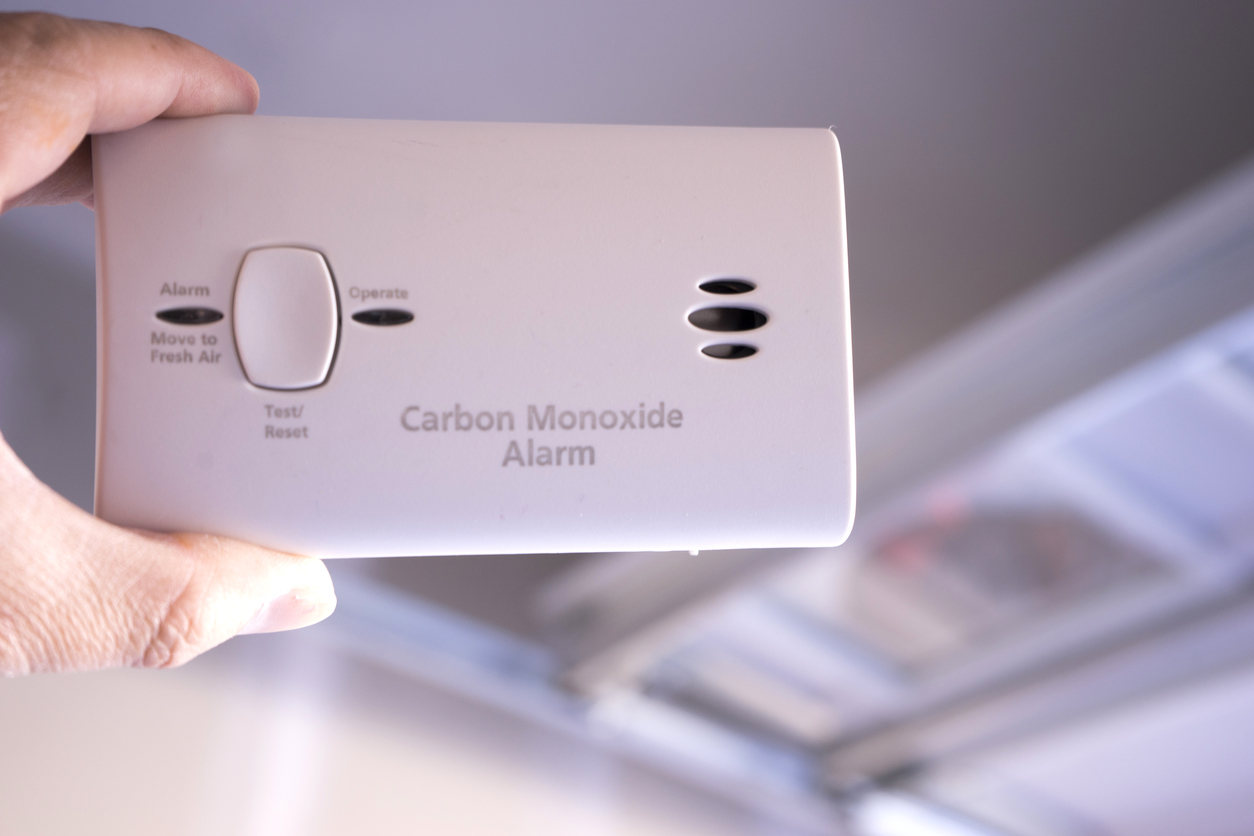
Carbon monoxide has the well-deserved reputation as being a silent killer. It is usually generated when fuels burn incompletely, allowing the lethal gas to escape into the air, and its lack of color, scent or taste makes it almost impossible to notice without a carbon dioxide detector. Natural gas and heating oil, wood and coal, gasoline, kerosene and propane that provide fuel for cars and trucks, fireplaces and furnaces, grills, lanterns and gas ranges can produce fatal doses of carbon monoxide.

The Centers for Disease Control cites carbon monoxide poison as the cause of 430 potentially avoidable deaths in the U.S. each year and calls it the “leading cause of unintentional poisoning deaths.” Statistics show that the death rate among men is more than three times greater than that for women. Fatalities among the elderly occur four to five times as often than deaths in the under age 25 population. Click here for the Top 10 Best Carbon Monoxide Detectors.
How Carbon Monoxide Detectors Protect Us
Most models on the market utilize an electrochemical sensor to detect the presence of the poison gas, according to cnet, and they rely on chemical changes to trigger an alert. A reaction creates a small current that allows the detector to measure the amount of the poison in the air. When the level reaches more than 400 parts per million (ppm), the sensor sounds an alarm.
Carbon monoxide detectors protect around the clock when they have central locations on every level of a home, near sleeping areas and any place where local codes require them. They provide the most effective defense with interconnectivity that makes all of them sound an alert when any one of them does. The National Fire Protection Association advises moving to a fresh air location as soon as an alarm sounds while making sure to account for every person.
Smoke Alarms vs Carbon Monoxide Detectors
Devices that create alerts for smoke or carbon monoxide may look about the same, but they provide entirely different kinds of protection. They usually have a flat and circular plastic case that mounts on a wall or ceiling. The significant difference between them is that smoke detectors react to a fire while the devices that detect carbon monoxide respond to the incomplete combustion of liquid and solid fuels. Smoke often creates a noticeable odor or a haze, but carbon monoxide never does neither.
The Different Types of CO Detectors
Manufacturers produce five kinds of carbon monoxide detectors with features and capabilities that distinguish them.
Combination Smoke and CO
UK Business Forums points out that a combination alarm offers convenience and protection from two “deadly threats in one unit.” Combination units save space and prevent the need to mount two devices that serve different purposes. While the appearance of dual detectors may not have an impact on a home’s décor, homeowners may prefer to minimize the presence of functional devices that have no decorative purpose. The maintenance of a combination detector requires half as much time for installation and for checking the batteries. Owners can save on an investment in home safety by choosing a dual-purpose device that serves two purposes. The Cost Helper website, cites the average price range for a stand-alone carbon monoxide detector at $20-$50, an amount that overlaps with the price for a combo unit at $40-$80. Shoppers can probably find both types for a little less or quite a lot more online or at a home improvement store.
Digital Read-out Detectors
A digital display provides access to information about the presence or absence of carbon monoxide levels in a home. Some devices refresh the data at periodic intervals of seconds to reassure homeowners of air that contains no carbon monoxide. The display may present the data in a variety of ways, giving shoppers a choice of methods to receive essential health information. Some models may indicate the concentration of CO in ppm while others produce a readout that resembles a stock ticker and provides a timeline history of the hazard.
An advantage of digital display detectors is the ease of reading the status of air quality even in low-light conditions. An LED backlight on some models facilitates visual assessment, and some detectors use the digital space to spell GAS. Most have an LED indicator that confirms an operational status for the device. The displays may show the data in red or black that can alert a homeowner to the need to vacate and find a fresh air location. Some models use red to indicate an alarm status and green for normal conditions.
Hardwired CO Detectors
A hardwired detector has a permanent mounting that requires installation by a licensed professional. The units may provide a more reliable capability of detection than battery-operated devices can produce, and they offer other advantages as well. Maintenance free, their permanent installation allows them to use a home’s electrical system for power, eliminating the need to test or replace batteries. Their hardwiring may provide a more accurate reading, and a purge/reset function contributes to reliability.
A safety feature that can compensate for a homeowner’s inability to observe the unit for signs of danger, an automatic emergency phone call to police or fire stations help increase the functionality of hardwired detectors. Medical professionals cite the symptoms of carbon monoxide poisoning as a headache, drowsiness, confusion and poor coordination among others. A hardwired system can offer essential alerts to first responders when it provides information about the location where a problem may exist.
Battery-Operated Carbon Monoxide Detectors
Several advantages of the battery-operated carbon monoxide detector can make it the choice of safety conscious homeowners, but it may have a disadvantage as well. Units that use battery power do not need hardwiring or access to an electrical outlet, making it convenient to put them anywhere except in front of a fan. When a battery runs low, the unit emits a beep that alerts a homeowner to the need to replace it.
A distinct disadvantage occurs if the weak battery dies before the owner can replace it. Wise Geek points out that a severe health threat can happen when the battery cannot produce sufficient power to allow the system to detect poisonous gas. A regular pattern of battery replacement that coincides with the time changes can help ensure an uninterrupted performance by battery-operated detectors. The power from a 9V replaceable battery lets the units require no installation and the ability to continue to work during power outages.
AC Plug-in Models
Advanced technology in AC plug-in models allows homeowners to install them in a standard wall outlet. The location of outlets near the floor for practical as well as aesthetic reasons may not work as well as other devices that usually work best a little higher on a wall. Most models have a 9-volt battery backup that ensures uninterrupted performance during the loss of power. Plug-in detectors usually last for up to 10 years using the electric power from the outlet, and they reset after they detect carbon monoxide in the air, according to Do-It-Yourself.
Types of CO Sensor Technology
Each carbon monoxide detector uses a sensor that receives a signal from a small microchip when the poison gas reaches a dangerous level, according to How Stuff Works. The purpose of the CO sensor is to identify and measure the amount of gas concentration in the air, according to Underwriters Laboratories (UL) standards. The noise alert that the sensor causes the detector to emit is about 85 decibels, about midway between a vacuum cleaner that produces 70 decibels and the 100 that a chainsaw creates. Three types of sensors offer various ways to achieve the essential goal of issuing an alert about dangerous air quality.
Biomimetic
With the information that nature provides, scientists developed biomimetic sensor technology to reproduce the reaction that CO produces on blood hemoglobin. Mimicking the environment, it creates a change in color of a gel inside the detector as it absorbs carbon monoxide. The design includes another sensor that notes the color change and sends a prompt to the processor to initiate the alarm. A biomimetic sensor needs replacing after it changes color.
Metal Oxide Semiconductor
When CO contacts the circuits on a silica chip in a metal oxide semiconductor, it lowers the electrical resistance. The processor performs its purpose of detecting the change in air quality and enables the alarm to create a sound. Sensors of this type require a significant amount of electricity that works more efficiently as plug-in models that get it from wall outlets instead of batteries.
Electrochemical
With a resemblance to the metal oxide semiconductor detector, the electrochemical sensor relies on electrical current to determine the presence of carbon monoxide. It uses electrodes in a chemical solution to produce the response instead of an integrated chip. In professional sensing equipment, the electrochemical instant detection and response (IDR) devices can deliver instantaneous detection of dangerous levels of CO.
Placing Detectors within the Home
An understanding of the importance of the placement of carbon monoxide detectors in a home may depend on an appreciation of the power of carbon monoxide to kill. The risk of unintentional death from breathing carbon monoxide makes the placement of detectors at critical locations in a home a matter of great significance. The density of carbon monoxide makes it somewhat lighter than air, but it mixes in instead of rising like heat or smoke.
States issue regulations that govern CO detectors, and the National Conference of State Legislatures publishes a list of states that have statutes requiring them in private dwellings. The Safety website recommends installing the CO alarms at about knee to chest level for single function detectors to approximate the height of a sleeping person. However, combo units that detect smoke need a location near the ceiling. Carbon monoxide detectors require a clear space around them where furniture or drapery cannot restrict the air flow. Protection from the effects of the deadly gas requires detectors on all levels of a home, including the basement, and at these strategic locations:
• near the entrance to each bedroom or at a central location for all of them
• kitchen
• living/dining room
• office
• laundry rooms that have a gas dryer
• garage
• any other place where a solid fuel-fired appliance can produce carbon monoxide
Testing and Maintaining CO Detectors
The permanence of hardwired detection systems makes them maintenance free as well as tamper resistant. They do not need a periodic change or testing of batteries, and they usually last for several years with little or no requirement for service. Battery powered detectors need monthly testing and fresh batteries each year, but homeowners may choose a regular interval that coincides with the time change to avoid a lapse in coverage.
Plug-in detectors require weekly testing to make sure that the alarm sounds. Any unit that does not respond to testing needs immediate replacement. Dust on the cover of a plug-in detector can interfere with the ability of the unit to detect the gas. A vacuum provides the best way to clean the detector, and the unit requires another test afterward.
Final Thoughts
Find out the laws in your area for detectors, and be sure that you exceed expectations. Always keep all detectors up-to-date and replace defective devices. Be cautious rather than fearful. Protect yourself and your family.
Additional Resources:
https://homesafetydot.com/article-sitemap-1-61cc84/
https://homesafetydot.com/article-sitemap-2-de7bff/
https://homesafetydot.com/article-sitemap-3-eb4e4a/
https://homesafetydot.com/article-sitemap-4-e75eb4/